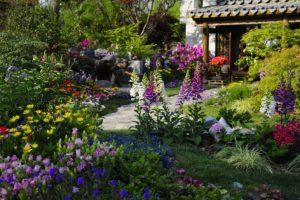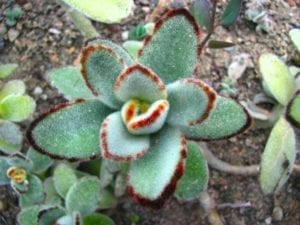With the ever-increasing challenges posed by climate change, gardening enthusiasts and homeowners are turning their attention to plants that can thrive even in the face of drought conditions. Creating a garden that is not only visually appealing but also resilient to water scarcity is a practical and eco-friendly approach. Embracing the beauty and diversity of drought-resistant plants can not only add a touch of vibrancy to your landscape but also contribute to sustainable gardening practices.
Here, we present 15 resilient plant varieties that will flourish in your garden, even during dry spells.
1. Lavender (Lavandula spp.)
Known for its soothing fragrance and delicate purple blooms, lavender is a tough, drought-tolerant herb that can endure harsh conditions. Its silvery foliage adds an elegant touch to any garden, while its ability to thrive with minimal water makes it an excellent choice for dry climates.
2. Succulents (Succulentae)
Succulents encompass a wide variety of plants, including cacti and other water-storing species. These plants come in various shapes, sizes, and colors, making them a versatile addition to any garden. Their unique textures and low water requirements make them an ideal choice for those looking to create a striking, low-maintenance landscape.
3. Russian Sage (Perovskia atriplicifolia)
Russian sage is a hardy perennial known for its delicate, silvery foliage and abundant, airy lavender-blue flowers. With its tolerance for dry, hot conditions, this plant can bring a touch of elegance to any garden, even during the hottest summer months.
4. Agave (Agave spp.)
Characterized by their striking architectural forms and fleshy, sword-like leaves, agaves are well-suited to arid environments. These striking succulents come in a range of sizes and colors, making them a popular choice for gardeners seeking to create a dramatic focal point in their landscapes.
5. Yarrow (Achillea millefolium)
Yarrow is a hardy perennial with clusters of small, daisy-like flowers that come in a variety of colors, including white, pink, and yellow. This versatile plant can withstand drought conditions and poor soil, making it an excellent choice for garden borders and wildflower gardens.
6. California Poppy (Eschscholzia californica)
Known for its vibrant orange and yellow flowers, the California poppy is a drought-tolerant annual that can bring a splash of color to any garden. Its ability to thrive in dry, sunny locations makes it a popular choice for gardeners seeking to create a lively, low-maintenance landscape.
7. Red Hot Poker (Kniphofia uvaria)
Red hot poker, also known as torch lily, is a striking perennial known for its tall, torch-like spikes of red, orange, and yellow flowers. With its ability to withstand hot, dry conditions, this plant can add a touch of drama and vibrancy to any garden, particularly during the summer months.
8. Rosemary (Rosmarinus officinalis)
Rosemary is a fragrant, evergreen herb with needle-like leaves and delicate, pale blue flowers. Its drought tolerance and culinary versatility make it a popular choice for herb gardens and ornamental landscapes alike.
9. Penstemon (Penstemon spp.)
Penstemon, also known as beardtongue, is a diverse genus of flowering perennials that come in a wide array of colors and sizes. With their tolerance for drought conditions and their attractive, tubular flowers, penstemons are a popular choice for adding vibrant splashes of color to garden borders and rock gardens.
10. Coneflower (Echinacea purpurea)
Coneflowers are resilient, drought-tolerant perennials known for their vibrant, daisy-like flowers and distinctive, spiky centers. Their ability to attract pollinators and their striking visual appeal make them a valuable addition to any garden, particularly during the summer months.
11. Lantana (Lantana camara)
Lantana is a colorful, heat-loving shrub that produces clusters of vibrant flowers in shades of red, orange, yellow, and pink. Its ability to thrive in hot, dry conditions and its long-lasting blooms make it a popular choice for gardeners seeking to create a vibrant, low-maintenance landscape.
12. Sedum (Sedum spp.)
Sedums, also known as stonecrops, are a diverse group of succulent perennials that come in various shapes, sizes, and colors. Their ability to store water in their fleshy leaves makes them well-suited to drought conditions, while their striking foliage and vibrant flowers can add visual interest to rock gardens and sunny borders.
13. Salvia (Salvia spp.)
Salvias, commonly known as sage, are a diverse group of flowering perennials known for their vibrant, tubular flowers and aromatic foliage. With their tolerance for dry conditions and their ability to attract pollinators, salvias are a valuable addition to any garden, particularly for those seeking to create a haven for bees and butterflies.
14. Verbena (Verbena spp.)
Verbena is a low-growing, drought-tolerant perennial that produces clusters of small, colorful flowers in shades of purple, pink, red, and white. Its ability to thrive in hot, sunny locations and its long-lasting blooms make it a popular choice for adding splashes of vibrant color to borders, containers, and hanging baskets.
15. Gazania (Gazania spp.)
Gazanias are resilient, sun-loving perennials known for their striking, daisy-like flowers that come in an array of vibrant colors. Their tolerance for drought conditions and their ability to thrive in poor, sandy soil make them an excellent choice for creating a colorful, low-maintenance garden, particularly in coastal regions.

Incorporating drought-resistant plants into your garden not only adds an element of natural beauty but also promotes sustainable gardening practices in the face of climate change. The resilience and adaptability of these 15 plant varieties make them valuable additions to any landscape. Also, these provide vibrant colors and textures even in the driest of conditions. By embracing these drought-tolerant plants, you can create a visually stunning and eco-friendly garden that thrives even during water scarcity. Further, this demonstrates the resilience and beauty that nature has to offer.
For further more ideas, check out Backyard Gardening: A Step-by-Step Approach.






